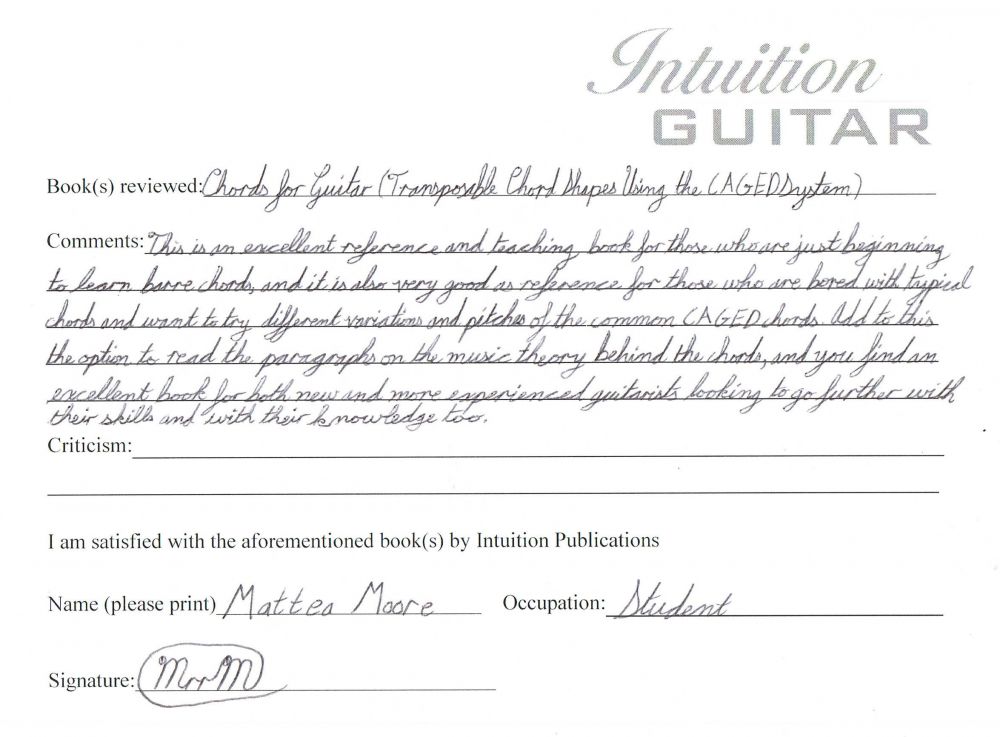
Reviews
There are no anonymous reviews on this website. There are reviews from professionals and reviews from students. At this point, mostly for the books that don’t have video presentations or examples. The reviews are shown in full on this webpage while on the book’s pages they are shown as shorter versions on carousel widgets.
Reviews from Professionals
I find and contact guitarists & teachers from all over the world and ask if they would be interested in receiving one of my books in exchange for their feedback. The paperback Book or eBook is provided in advance of the review in order to allow them to review it and there is no further compensation. They are from a variety of geographic locations including Canada, USA, UK (England), Singapore, New Zealand, Slovakia, Ireland, South Africa, Netherlands, Scotland, Denmark and Italy. With their approval, I post their feedback onto this website.
The professional’s reviews are accompanied with reference to who they are, what they do and their qualifications so there is an identity behind each review. The professionals aren’t soliciting reviews and aren’t reviewing by vocation so it’s a once off. In most cases one book is reviewed per professional, occasionally two.
Reviews from Students
Hand-written & signed reviews from my own clients of guitar lessons, some of which include a photograph of them holding the book. Many of my students come for years so these reviews won’t increase greatly in number over any short period of time.
Learn to Play Guitar
Reviews from Professionals
“We loved the book. The information was well paced and concise enough not to overwhelm. Any beginner would definitely benefit from having this book, and it’s a great reminder for those who might have forgotten details or are looking for them.” The Music Garage
“There’s two ways of learning the guitar – the first is two learn enough of the basics to fly towards playing your favourite songs competently, and the second is to intensively gain an understanding of the instrument by forming a solid foundation through taking your time with it in the early stages. The book titled “Learn to play Guitar” by Gareth Evans is of the latter approach. Through reading and learning from this book, players can discover a deep, extensive and in-depth approach to the technique, theory and everything else related to being a good beginner guitarist. Newcomers can learn positive and productive exercises to train their body to better play the guitar (not just their fingers) and across the 120 or so pages within, it’s clear that the writer has put a lot of time into figuring out the right approach for starters to take when adjusting to the standard 6-string. Would recommend this for anyone who is looking to get a really solid grip on how to play the guitar, and also to tutors who are looking at ways to improve their own tutoring abilities.” Spiderhands Productions
“I think this book is great. It covers all the stuff I teach, in a really clear but detailed way. I always find that different people take different amounts of theory to others, but this would be a great book to keep referring back to during lessons and song learning. It’s pretty much exactly how I would make a guitar tutor book.” Kieran Wade Guitar
“Had a look at the book and all I can say is….awesome. To me, it is well laid out, easy to look at and there is the supplemental material to top it off. The theory may get tedious for some…its hard to not teach theory but most people seem to have an aversion to it…..the idea of discipline I think.” B Sharp Music
“Plenty of detail that goes into posture, hand position, thumb position, etc. The notation and strumming is really good here because it builds up in stages. In a real life lesson, you can introduce it in this way piece by piece and not overwhelm the student.” Larne Guitar School
“Learn to play Guitar is an ideal companion to support the beginner on their new found musical journey. Highly recommended.” RSL Liam Cain
Reviews from Students
“A very good book for beginners to intermediate guitar players, teaching the reader about the fundamentals, chords shapes, techniques, tips and how to read music (ed: I should point out that it covers only the rhythmical aspect to be used in conjunction with guitar TAB), in depth. It includes lots of examples and 42 tracks to download. Lots of pictures and easy to read.”
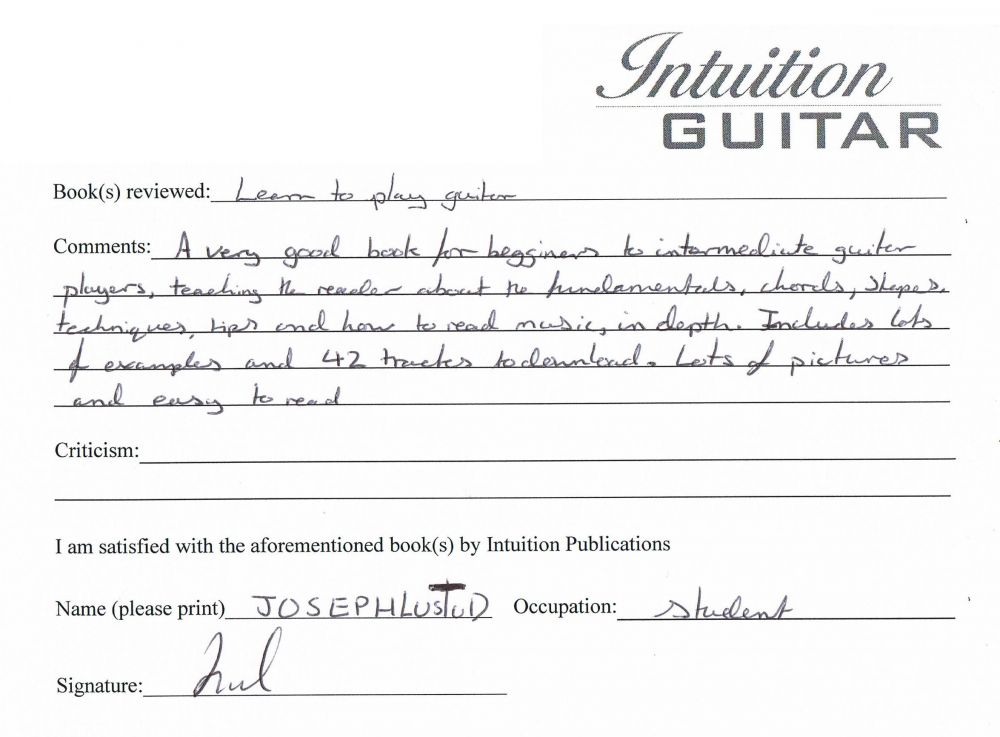
“Gareth is an excellent guitar teacher and guitarist. All of his books are concise and easy to follow. I would thoroughly recommend him to anybody.”
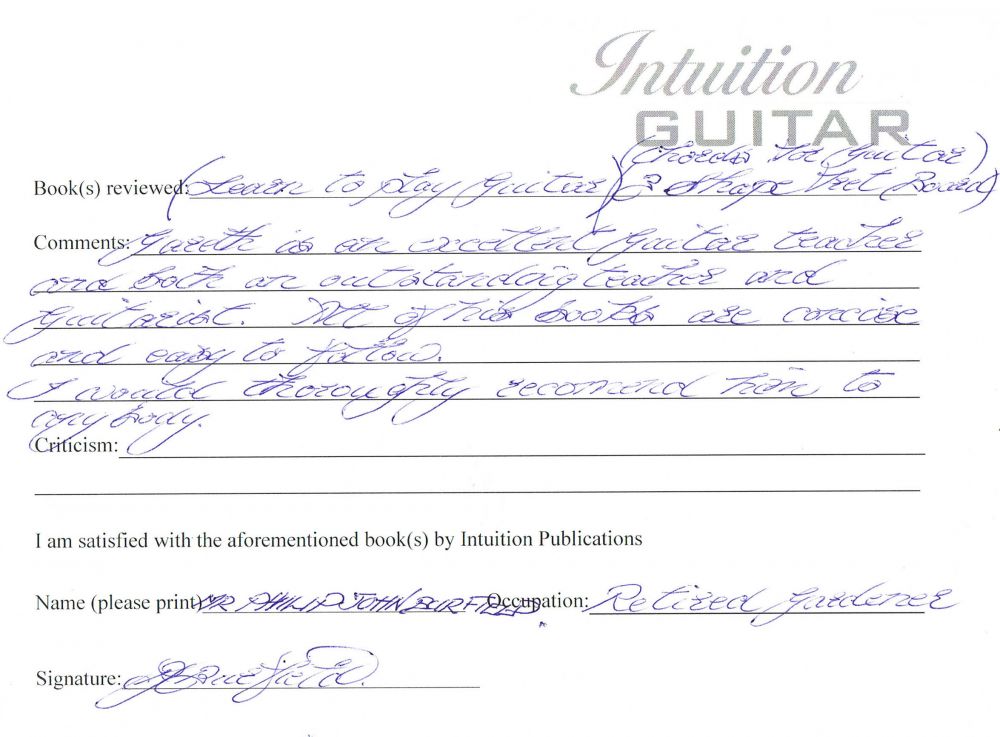
“I have been working through this book ever since I started lessons with Gareth. I think it is an excellent book and has helped me progress a great deal! It is easy to understand and has clear diagrams so you can see what you are doing.” Criticisim: “It would be good if all the songs came on a CD with the book” (ed: just for the readers info, they come as downloadable tracks).
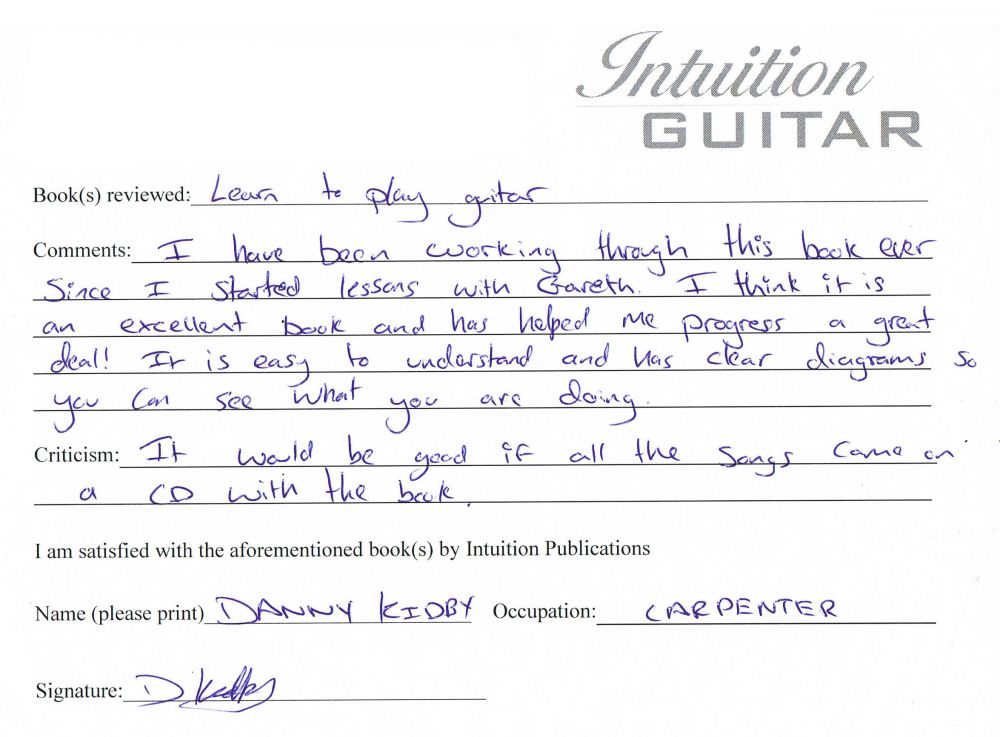
“The book is clear and easy to follow. It is helpful for all levels. It includes some excercises which build your skills up to playing the chords of a tune/song.”
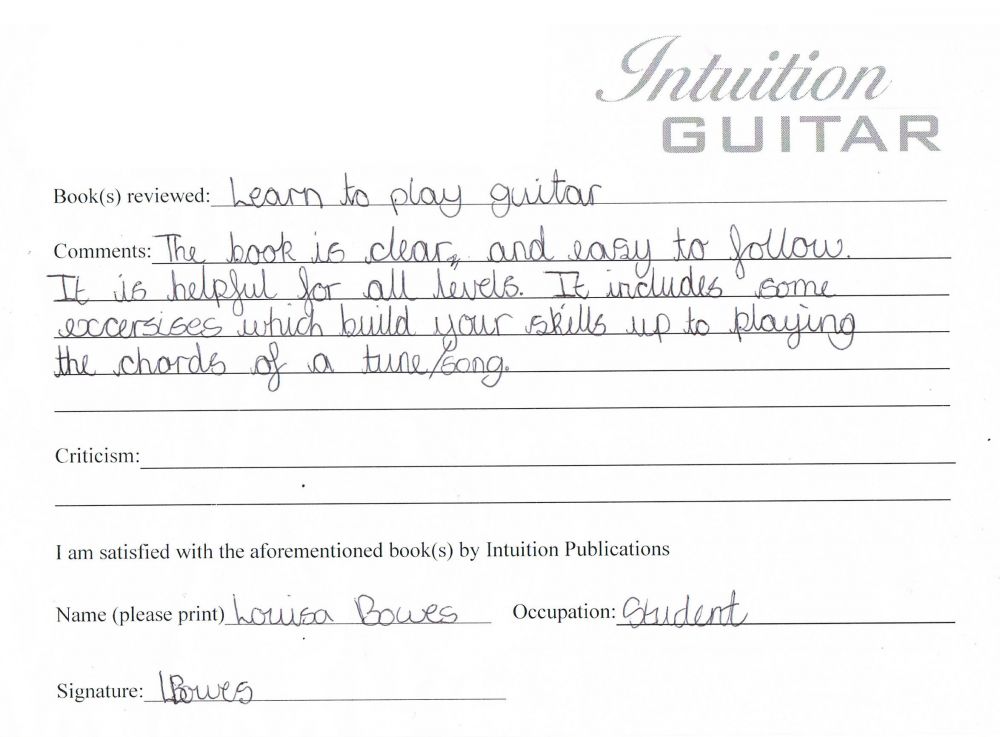
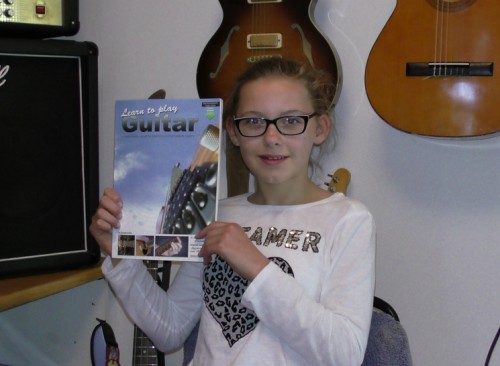
“Excellent teaching, helpful books with useful illustrations. As the author of the books, Gareth has a complete understanding of their contents. Being a beginner to guitar, I ask numerous questions about the books!”
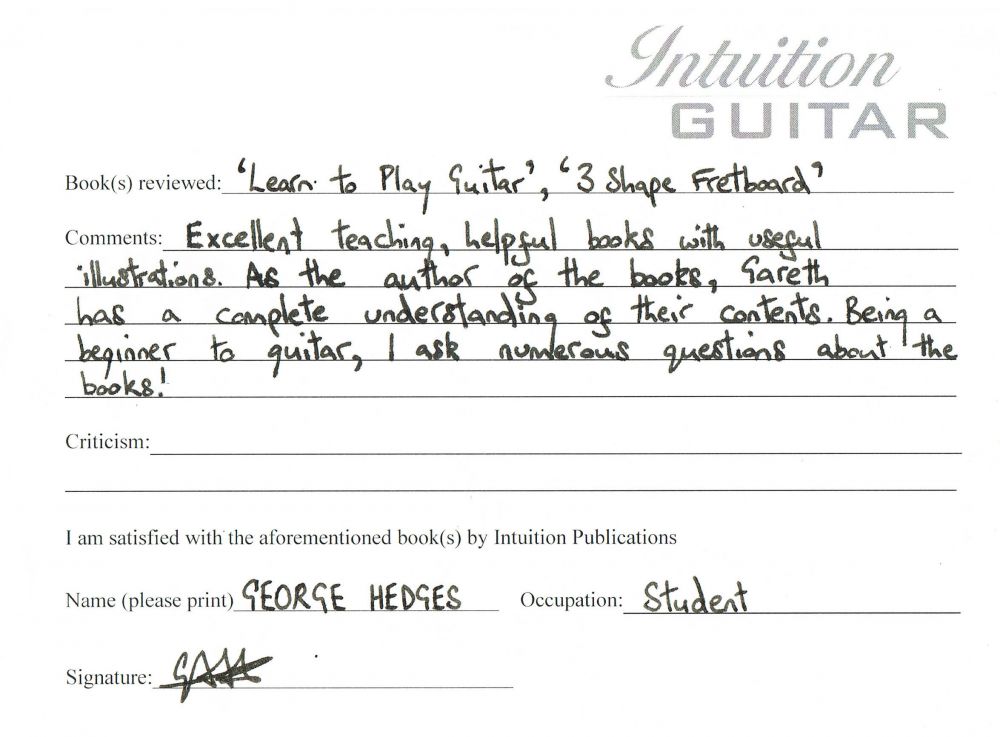
“Easy to understand, taught me TAB reading, sight-reading and chords. You can learn guitar at your own speed. Book starts easy and gets harder as it goes on & has good diagrams to help you understand.”
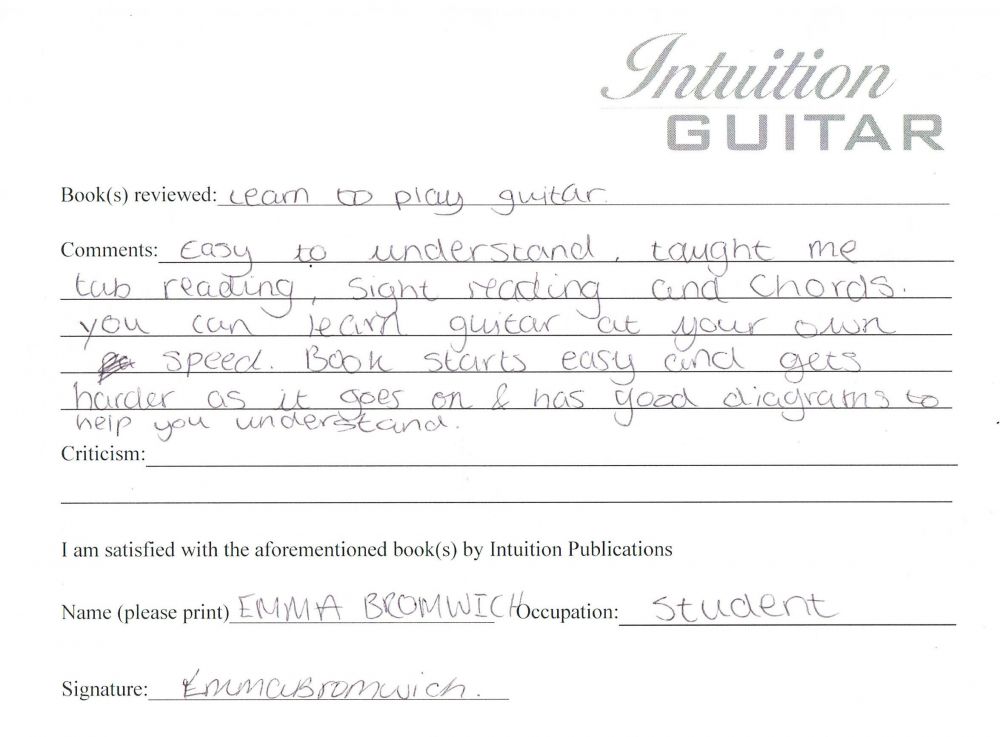
“The Learn to Play guitar for Beginners is a very good guide for technique and theory. The book is set out very well with detailed photos, which help the learning process.”
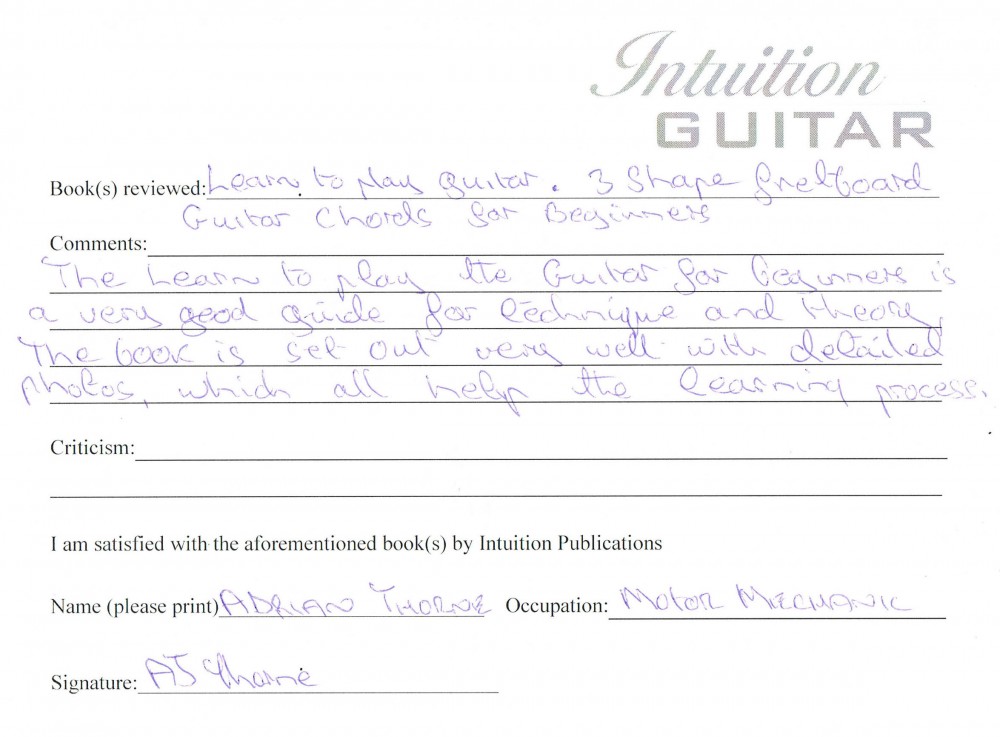
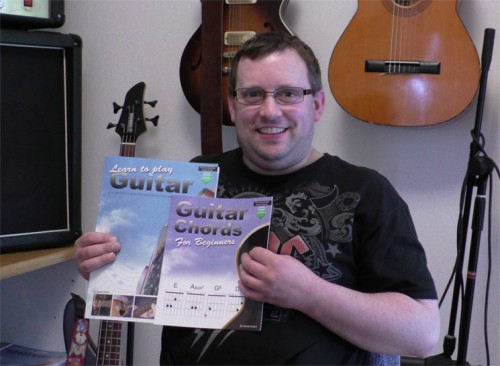
“Easy to follow, learnt to play a scale which turned into a tune. Lots of exercises and techniques, with backing tracks to play along to.”
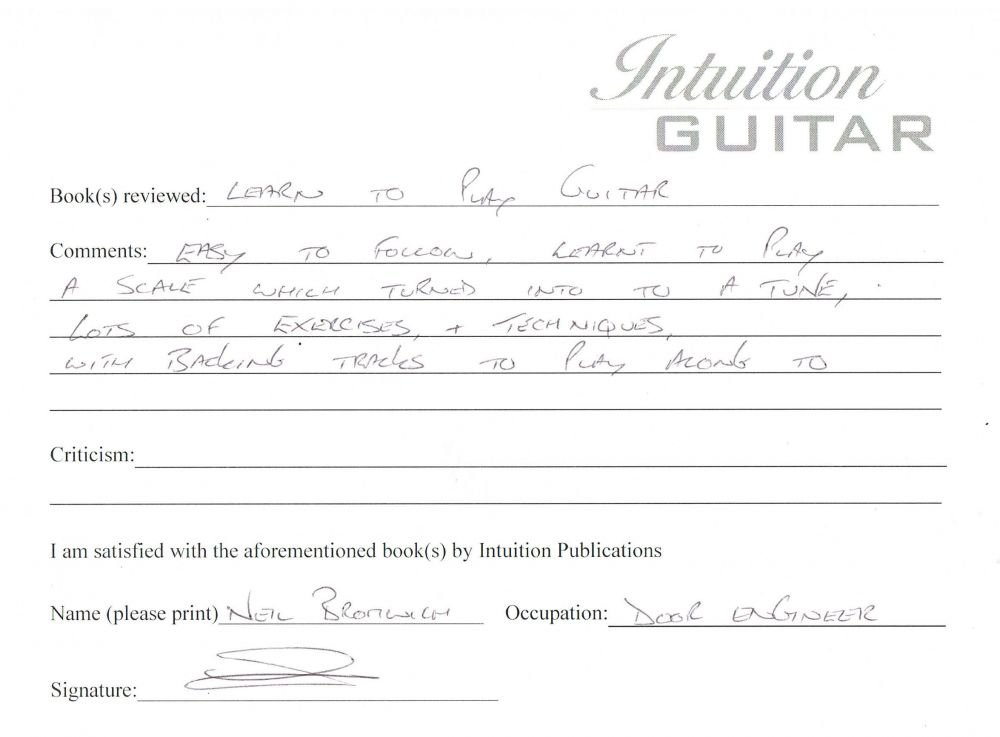
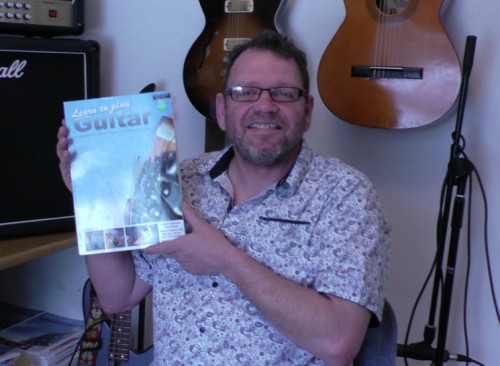
“My knowledge of the Guitar was limited so I requested that I start at the beginning. My first lesson was to understand the basics of the guitar and the introduction of Gareth’s Learn to Play Guitar book. I’ve found the systematic way this book has been written has enabled me to progress consistently, playing guitar at a pace that suits me although this is enhanced and compliments the book by having lessons. The music downloads from Intuition Guitar give a brilliant sense of rhythm and encouragement to play.”
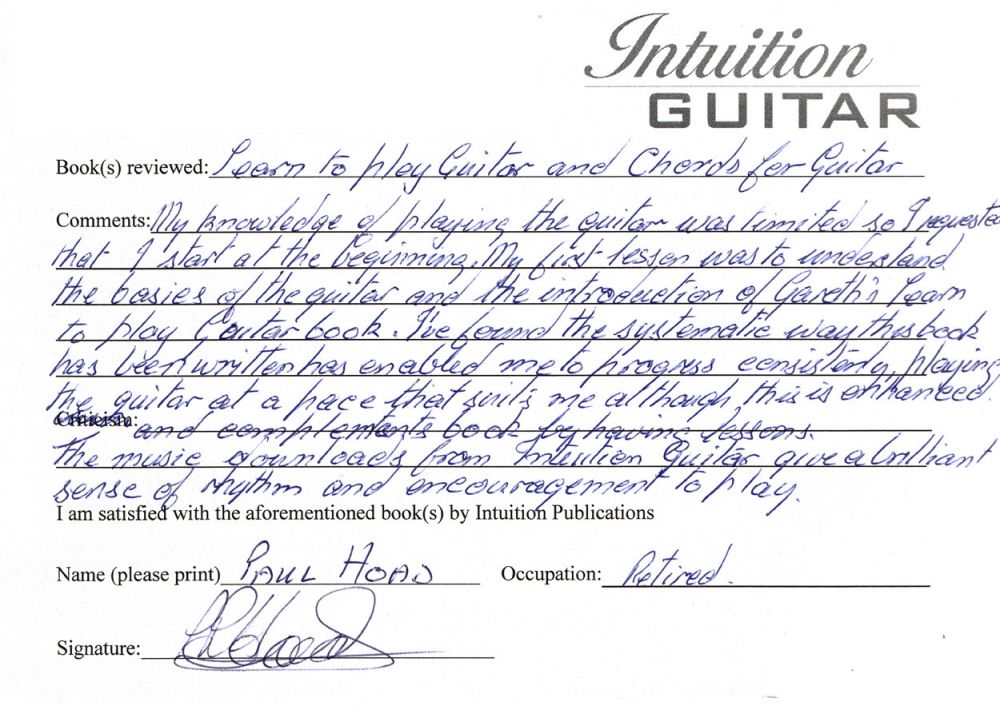

“The book is very easy to learn from and includes lots of interesting music theory. It has pictures and diagrams to help you understand the guitar.”
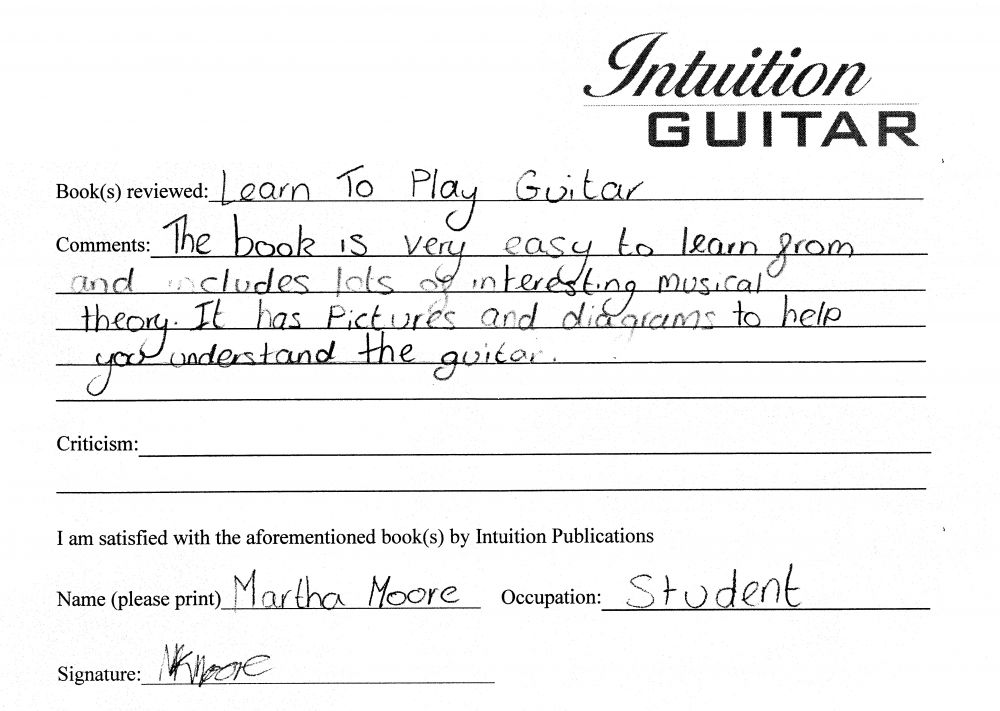
Guitar Chords for Beginners
Reviews from Professionals
“Looks fab. I particularly like the different ways of playing the A chord. The physical warm-up exercises for flexibility are also good. It is good that movable major and minor barre chords are shown as partial versions to make them initially easier, and beginners might find extra interest where near the back of the book easy open versions of other more exotic chords are shown, such as Dm(maj7), the “James Bond” chord.” Campbell Murray
“Guitar chords for beginners is uniquely practical among beginner guitarist books, in that it presumes no prior knowledge, and its primary focus is to help the beginner get started with chords, rather than bamboozling them with too much information. To my mind this is the best way to keep new players engaged in their learning and give them the opportunity to progress. The descriptions and pictures of how to play the first batch of chords make learning from this book a more useful experience than many chord books, which often feature a mind-bogglingly endless ream of fret-board diagrams and dots. If I were to offer a criticism it is that more emphasis could be placed on the method of moving from one chord to another, something that causes difficulty in a great many beginners, but to be fair the book is a book on guitar chords and it delivers exactly what it promises better than most.” Martin Sean McConnell
“I like what’s been put together! The information covered in technical issues for beginners especially explaining the difference between chords on piano and guitar is great. I think starting with the small position chords for C and G etc and building up to full position is also really important for beginners. The picture diagrams of hand position is a nifty feature, I know lots of beginners respond more to visuals and will often revert to looking at the hand pictures rather than the chord diagrams. Also think the added audio clips are a great feature so students can compare the sounds of their chords with the audio for reference There could be a couple of chord progressions at the end of each section (apart from the song suggestions at the end of the book) and strumming patterns. That would be an added feature that I think could work nicely, although this would make for a larger book and it is only £1.99 for the eBook. Otherwise I think what’s been put together is great :)” Anthony Bierman
“It’s a very comprehensive book containing chords from the beginning stages and beyond. Everything is very well explained with no stone left unturned. I’d highly recommend it to anyone who’s starting out with the guitar.”
Nigel Elliott
Guitar for Kids
Reviews from Professionals
“I have been using Guitar For Kids on a few of my children for a few weeks now. The children really love playing along to the backing tracks and they have been more enthusiastic about practicing because they have something to play along to. The content of the book is well thought out and each musical aspect is introduced gradually as to not swamp the child with too much too soon. I especially appreciate the use of both British and American names for crotchets/quavers etc. This is seldom found in most publications. I recommend this book to both teachers and learners” Ben Parker
“Really detailed and thought out well. It’s good that this book presents the easy to difficult chords. I like the introduction of notation as well. When you present it in stages, it’s not too hard for people to pick up.” Larne Guitar School
“The book is bringing very fundamental steps in learning how to start playing the guitar for its readers. Readers will get acquainted with a guitar as a tool and learn how to play it in the correct way. The most important point for beginners, which concludes the guitar technique of balancing right and left hand as well. Readers are able to learn how to play music through tablature, how to read conventional notation and how to play basic chords. Guitar for Kids is also providing very useful audio samples of presenting sample melodies so that they will hear how the melody should be performed when they are playing the guitar. Readers of this book who want to know how to play the guitar in a professional way should pay extra attention to guitar techniques, which is presented here. It is very important to get the right gestures in holding the plectrum, how to pluck the strings and how to use the fretting hand. The only thing that the book lacks is explanation of need of using the metronome when practicing guitar technique. The book Guitar for Kids is written in a very acceptable way accompanied by lots of pictures. I am recommending to read this book not only for kids, but also for everyone who wants to start playing the guitar in the right way.” ATP Music
“I have taken a look at the book and think it is very well done. The layout is definitely kid-friendly and I like how it starts with TAB before jumping into standard notation. The guidance on holding the pick like holding a pencil is very good. I am going to steal that if you don’t mind. I’d say some of the text might be a bit much for some younger students. This can distract from the primary task at hand. I think, with young students especially, its difficult to find the right balance between providing enough information and giving more than needed. I would err on the side of less-is-more. As far as the overall layout and approach, I think you’ve done an excellent job.” Curt Brady Music
“Gareth has written a really well thought out first book for teaching young children how to play. The fact that he teaches tablature and takes the time to find a logical way to add rhythm makes this method a step above other similar books. I’ve taught guitar for 30+ years and it’s always a been a challenge to find a book that doesn’t talk down to the students. This one is definitely the one I’ll be using.” BL Guitars
“It looks like Gareth spent a lot of time writing Guitar for Kids. I think the illustrations are very helpful in keeping people’s minds interested and engaged. The fact that it also includes audio will help them understand how it should sound as well.” Lincoln School of Music
“I think it is really cool! I looked through Guitar for Kids thoroughly when I received it and I think its great. I will be recommending that my students buy one as soon as I have some the appropriate age. I would be happy to recommend.” Phoenix Guitar Lessons
Reviews from Students
“This book has been a great start for me to begin learning the Guitar. Gareth writes all the songs and I really like learning to play each one. The colourful character also make the book super fun. I would recommend this book to anyone starting guitar.”
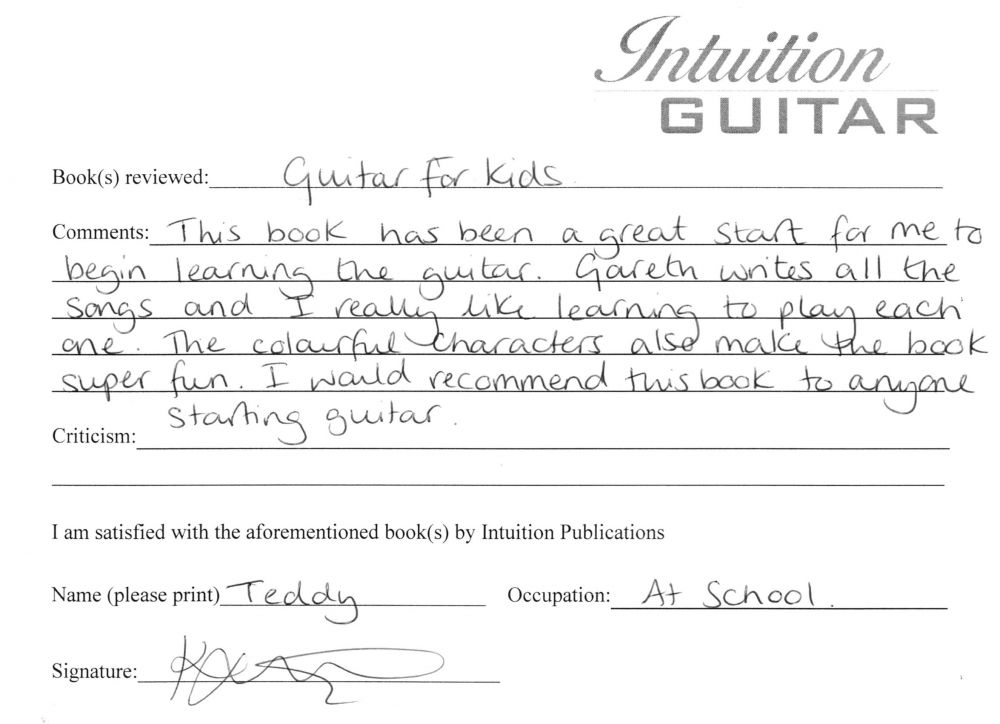
“This book is great. I bought it for my 9 year old and he loves it! It has very clear texts with excellent audio tracks that can be downloaded for free or found on youtube.”
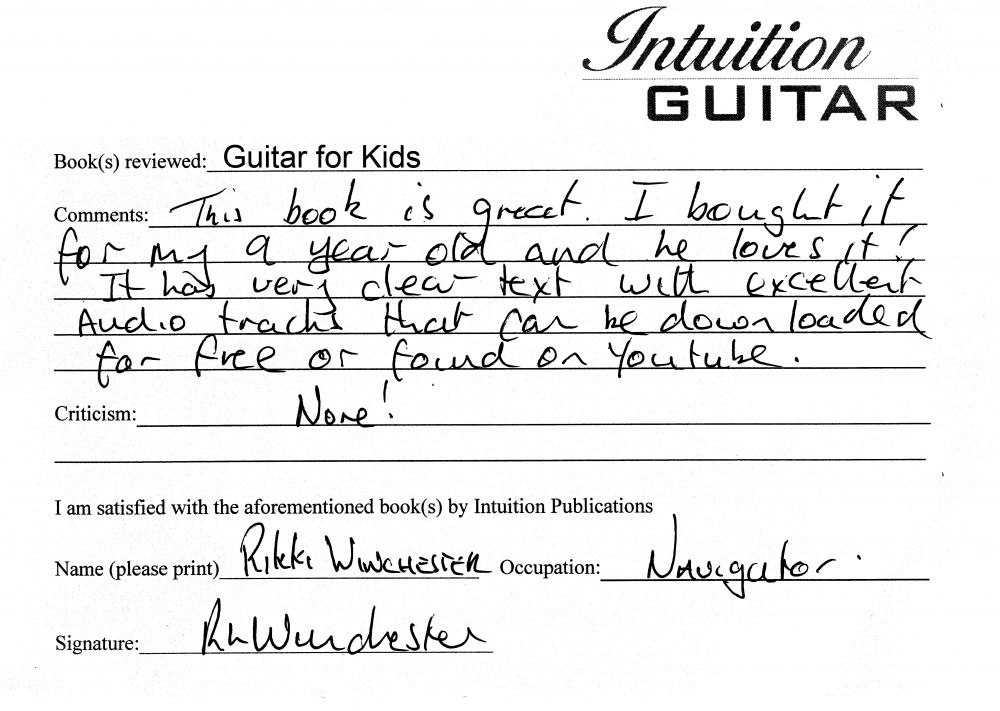
“Good songs and music for beginners. The chords are great going from EZ to the proper chords. Criticism: The pictures / cartoons are a bit more for babies but the drawings are good.”
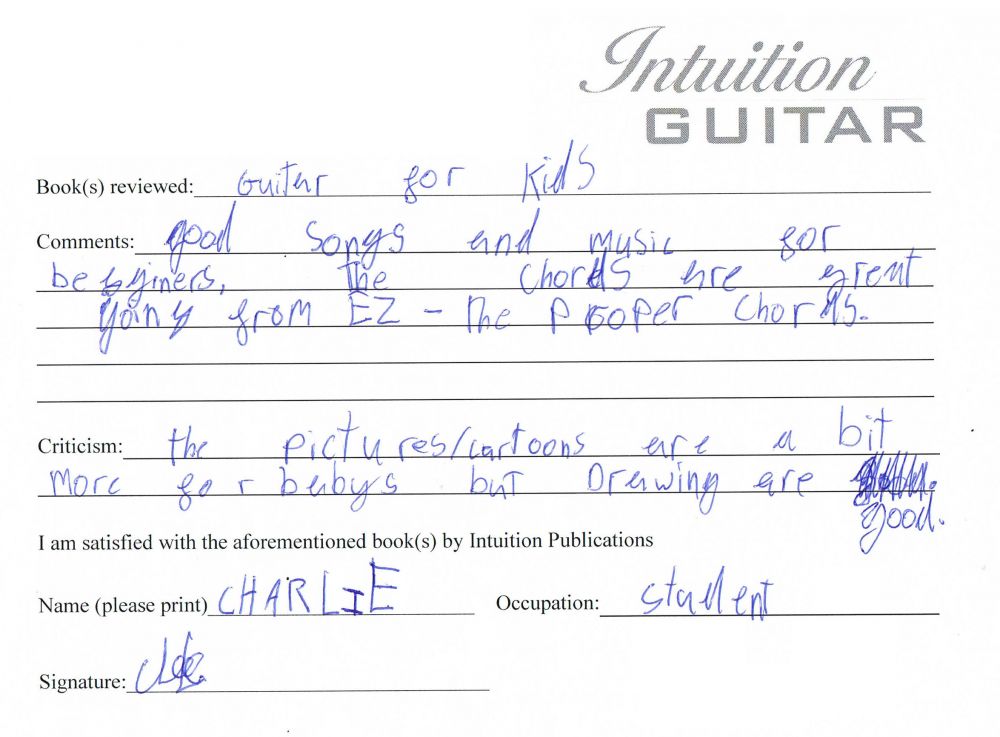
“The book Devon has been using is great. It is simple enough for him as a complete beginner to follow, but challenging enough that he’s never been bored with it. The book has taught him the skills (along with Gareth) to easily progress to the next level. Fun and educational!”
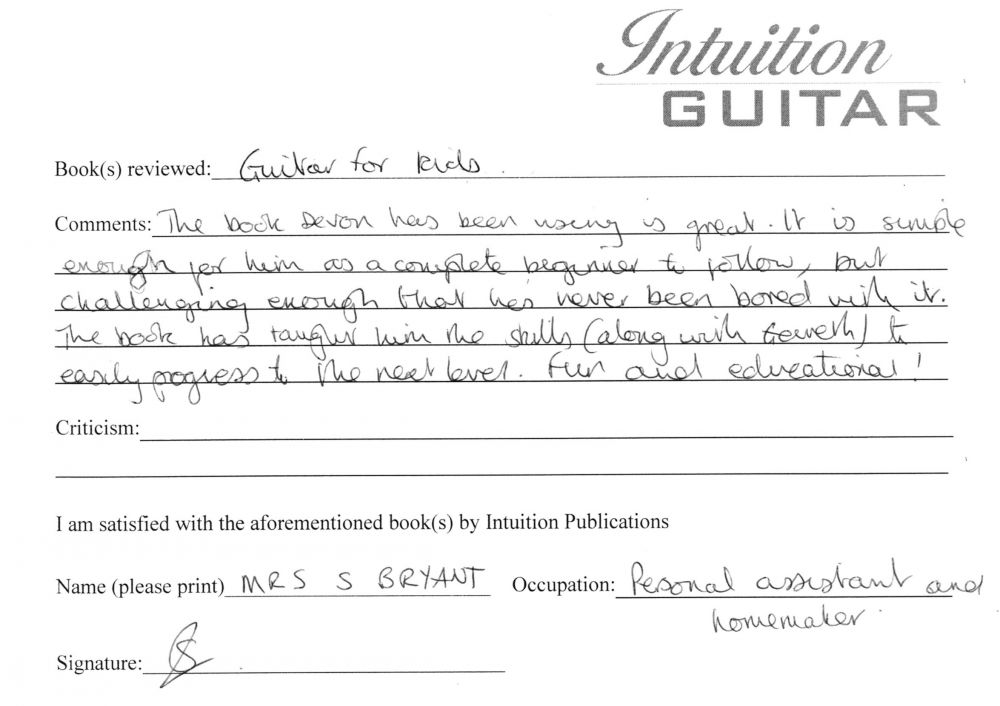
Stretching Exercises for Guitarists
Reviews from Professionals
“With Stretching Exercises for Guitarists, Gareth Evans has put together a collection of exercises, advice and insights that are both useful and entertaining for guitarists. I enjoyed very much. Highly recommended to any musician who would like to improve and enrich their warm-up routine.” Lorenzo Micheli
“Aside from all the books dealing with the best methods of learning guitar, music theory and all, there are few books focusing on the right practice environment and a healthy setup for your body. If you’re interested in the latter – and you should be – ‘Stretching Exercises for Guitarists’ is a good start. If you have been lazy about warming up for playing or practicing, trying a couple exercises from this book will help you remember and experience how beneficial this part of your practice routine is. After a short introduction, the book gets right to it and provides you with various exercises for each area of the body.
I like the simple instructions and clear drawings which rule out any potential misinterpretations. The book could be read from beginning to end, but can – and should, in my opinion – be used as a flexible tool during your practice time. Thanks to the structure, you can simply focus on one body area if needed or pick one exercise from each section to have it all. Of course, after a while you might pick your favorites and build your own little stretching routine.
A seemingly small, but actually crucial factor contributing to me liking this book is it’s size! It’s small enough to bring with, no matter how light you travel, and works perfectly as a reminder and tool in your everyday life. Let’s face it: Warming up isn’t everybody’s favorite part of playing an instrument and most people tend to neglect it: ‘Stretching Exercises for Guitarists’ is the small, practical reminder and help that may convince you to start.” Ingo Stahl
“I think this is an excellent publication. I was actually using some of these exercises already e.g. Forearm Flexor 4.3 – 4.5 – 4.8 etc. However, I find the book very thorough yet concise. As a Classical guitarist I would have liked to see some mention of the use of a footstool. Other than that the book is excellent.” Alan Grundy
“As a guitar teacher I often come across students who have poor reach on the guitar. The student usually puts it down to having small hands but having been practicing my own hand stretching exercises myself for countless years I know the story is different. This is the first book I have come across on the subject and I’m really glad to have found it. However, not only does this book cover hand stretches it also covers good posture and other exercises. I find the shoulder rotation exercise extremely valuable – My body isn’t as young as it used to be and four, one hour sets with a P-Bass around my neck can be hard to endure without some preventative maintenance exercises like these. The book is well written with clear and concise diagrams and covers the key areas of the body that can benefit from stretches. The exercises are backed up by a medical professional too which is great to see.” Manawatu Musician Makers
“Stretching Exercises for Guitarists is a great book to have around. Recently my hand and wrist had become numb and stiff from using a mouse. I found the ‘Wrist Flexion Stretch’ and it worked great. This little exercise released the tension from my wrist and the sensation of numbness soon faded. This is a book that every guitarist should have, a great tool that will help keep you playing.” Victor D’Ablaing
3 Shape Fretboard
Reviews from Professionals
“A logical and thorough approach to understanding scales, intervals and arpeggios on the guitar. All related to the universal CAGED idea of fretboard layout. Plenty to study and apply to your playing.” Hedley Timbs
“Do you have ‘favourite positions’ for certain scales? Do you sometimes “translate” certain scales to a mode of another scale that you know better (e.g., when playing in D major, you first figure out it’s the same as B minor, and then you “think” in B minor)? When trying to play a scale do you sometimes get lost by mixing up different visually memorized patterns? If you answered at least one of the above questions with ‘yes’, the book 3 Shape Fretboard by Gareth Evans can help you bring your fretboard and scale knowledge to a new level, allowing you to move much more freely when playing melodies and solos. On top of that, your playing will also start sounding more natural and melodic, because by understanding the function of each note in the scale, you will be able to choose the notes in a more musical way.
3 Shape Fretboard by Gareth Evans is a thorough workbook for learning to understand and play scales on the guitar. The emphasis here is on understanding the scales in terms of intervals, and being able to find the correct intervals everywhere on the fretboard. Many other books focus on fretboard diagrams to explain scales on the guitar, which often leads to a sort of visual memorization of the “correct points” on the fretboard. While this in itself is not necessarily a bad thing, Evans’ book goes much further by enabling the guitarist to really understand the scales in the sense that he/she knows the functions of the different notes in the respective scale (e.g. root, third, fifth, etc.). This is paramount for using scales in a musical way, instead of just playing theoretically correct notes in memorized patterns.
After reviewing some basics about the guitar fretboard and about key signatures, the book starts out by introducing three fundamental one- octave shapes of the major scale. So instead of learning seemingly unrelated patterns on the whole fretboard, the major scale is reduced to three basic shapes that repeat everywhere on the fretboard. In this way it becomes much easier to understand the function of each note in the scale, which is important for using the scale in a musical way. Combining the three different shapes leads to the complete scale patterns across all six strings.
The scale shapes are also related to the basic chord shapes, which helps to unify one’s scale and chord knowledge. I think this is a very important point because I’ve often noticed with students that they view playing chords and playing melodies as two totally different things. Yet, being able to see the chord shapes as part of the scale shapes helps a lot in playing musically over chord changes.
The same approach is then taken for many other scales (natural minor and the other modes of the major scale, harmonic and melodic minor and their modes, pentatonic scales, etc.). While it is made clear that the notes of the different relative modes are of course the same, it is emphasized that it is important to practice and understand each mode separately, simply because the individual notes have a different function in each mode. A melody in C major may not work well in E phrygian, even though both scales share the same notes.
The sheer number of different scales and modes may seem overwhelming, but the knowledge of the three basic shapes and a basic understanding of intervals will help a lot in seeing through the jungle. This is why the book emphasizes the importance of understanding and being able to play all types of intervals everywhere on the fretboard. This knowledge, combined with the knowledge of scales in terms of intervals, will make it much easier for you to play any scale in any key anywhere on the fretboard.
Apart from scales, the book also discusses the most important triad and seventh chord arpeggios, which provides yet another view on intervals and on the corresponding scales in which these arpeggios are contained. Practical questions (for which you’ll need your guitar!) throughout the book with answers and audio examples (via the website) complete this tour de force of fretboard and scale knowledge.
Obviously, this is no book to sit down and just read. This is a workbook that you have to read with the guitar in your hands, and you need to play and think and listen for many hours so that the concepts can settle in your brain, ears and fingers. However, after having put in the required effort you will be rewarded by complete freedom on the fretboard, regardless of what you play.” Mathias Lang
Extract from the full, more detailed 1,086 word review:
“There is clear evidence of many hours of dedication, organization, and piece-by-piece construction resulting in a detailed and extremely practical guitar instruction / reference manual. Be forewarned – you will not digest this in a day or two.
The book begins with an overview of the fundamental structure of the fretboard and the positional relationship among the frets, strings, and notes. As the title indicates, the foundation of the book is based on 3 shapes (a fixed note pattern) on the fretboard that contain the notes of a Major or other scale classifications. These shapes are positional in nature and referred to as Low, Mid, or Upper. The positioning of the anchored root note remains constant but the remaining scale notes either cluster toward the nut (Low), beneath the anchored root (Mid), or drift toward the bridge (Upper). My description may be somewhat fuzzy but the concept is easily grasped with the aid of the illustrations within the book.
The book explains how to move these shapes both vertically and horizontally on the fretboard and provides methods of shape connections that eliminate any obstacles to full fretboard navigation. The linkage between scales, notes, intervals, and the fretboard is fully self-contained and presented as a single entity. I have not seen the scales specifically presented in this fashion but can immediately appreciate the practical application opportunities. You will understand scale construction and theory if you take the time to understand the concepts reviewed. The ability to play any particular scale, any place on the fretboard, right when you need to, is not only powerful fun but also quite comforting. Enjoy your arrogance, well earned. There are multiple, comprehensive, illustrations and tables sprinkled throughout the book that are essential for understanding and exploration of the guitar. A wealth of information and a unique, pattern-based key that will open the door to endless musical possibilities. You only have to invest the time in order to earn the key that will allow passage. Conifer Guitar
“I think the 3 pattern approach is very interesting and well documented. There is lot’s of good material and I like the approach. Very well organised, complete and clear with plenty of diagrams.” Fabien Aubry
Chords for Guitar
Reviews from Professionals
“Having played guitar for around 8 years now, I have spent many an hour scouring the internet and local libraries for books and information or clues on how to improve and perfect my skills. Allot of the time I have found myself trapped between overbearing simplicity and overwhelming music theory related language. Gareth Evans’ ‘Chords for Guitar’ proved to be the perfect midground. Furthermore, it touched on something I have personally had issues with when writing or learning new music. I had wanted to start playing less with a capo, and more with an ability to transpose chords and find the right key just by being more familiar with the fret board in it’s entirety. This book teaches you exactly this.
‘Chords for Guitar’ is very easy to navigate through, not complicated to read and understand, not show-offish, and not overly simple. I learned allot from it, the tab diagrams were consistent – you don’t need much, if any, music theory knowledge to benefit from this book. You can skip to any particular section and immediately get practicing. Everything is clear and concise. The way in which the book is written is extremely inclusive and welcoming – not wanting to make any reader feel above or below par – whatever your level, wherever you are at in the learning process, this book will touch on important lessons that you can take with you to all genres of music. Highly recommended for anyone who wants to further their skills and knowledge on the guitar.” Rebecca Cullen
“At the School of Guitar we always use the CAGED system but we have never seen it applied so well to all chords. There are many books and resources that use the CAGED system but they are normally limited to major chords or minor chords and a few more. This excellent book uses it brilliantly applying it to every chord you can imagine. I love the way each transposable version of the chord is linked to an open chord. It really highlights the relationship between chords and the notes of each chord. We can’t recommend this book highly enough. For the beginner or intermediate player it is an excellent reference book. For the more advanced player (or a player who wants to become more advanced) it is a fantastic guide to better understand the theory behind each chord (and not, like most chord books, just a bunch of shapes to learn off.) Not only is it the best CAGED book of chords, we would go further and say it is simply the best book of chords we have seen.” School of Guitar
“Chords For Guitar is written in a concise and clear manner that will be easy to understand by anyone with basic music knowledge. While many areas of chord construction and fret-board application are vague and often debated, Chords For Guitar offers a consistent and simple approach. It will prove to be a great tool for those hoping to expand their knowledge on the fret-board.” Auckland Guitar Lessons
“Gareth Evan’s guitar chord book is one of the most thorough and in- depth books I have ever seen. If you’re armed with one of these books, you will have everything you will ever require to know all about chords.” Tony Cox
“This book is subtitled ‘Transposable Chord Shapes using the CAGED system’. For those students of guitar who are looking for an explanation of this famed system of learning the guitar fretboard, in a relatively fast, painfree and efficient manner, this is a wonderful book. The writer teaches the system particularly in the way that it can be applied to chords. Gareth Evans explains clearly the composition and theory of chords and the practical book has a marvelous table of them. One might spend a lot of time searching here and there from website to website, but it will save much time and frustration to get it all here in this well set-out publication. You will find many subtle chords that you hadn’t expected were easily movable. Great book!” Marion Arts
Reviews from Students
“This is an excellent reference and teaching book for those who are just beginning to learn barre chords, and it is also a very good as reference for those who are bored with typical chords and want to try different variations and pitches of the common CAGED chords. Add to this the option to read the paragraphs on the music theory behind the chords, and you find and excellent book for both new and more experienced guitarists looking to go further with their skills and with their knowledge too.”
